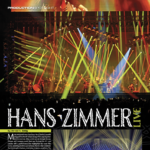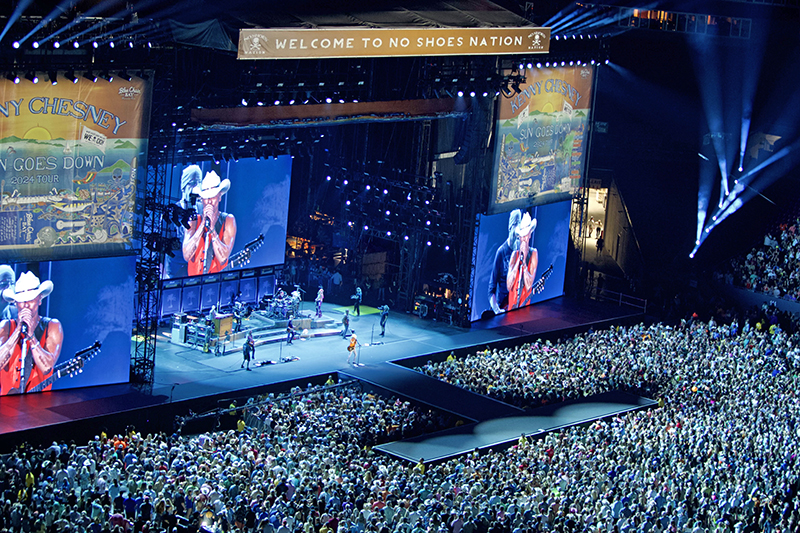
On Saturday, April 20, 2024, Kenny Chesney was back at Tampa, FL’s Raymond James Stadium kicking off another tour. His Sun Goes Down 2024 Tour 2024 will play a range of NFL stadiums and amphitheaters this summer. Back for their 22nd year supporting Chesney was Production Manager, Ed Wannebo, and Lighting Designer Mike Swinford, who both worked on Chesney’s first headline tour in 2002. Also, on the lighting team was another long-time Chesney vet, Programmer Mark Butts, who goes back to that first tour as well, and Lighting Director Philip Ealy, who’s been directing the lighting for 11 years on the road. You can tell a lot from a tour team, and the Chesney team has a lot of fun, which comes directly from ‘Mr. Fun’ (PM Wannebo) and Chesney himself—who is intimately involved in every detail of his tour. They all, including Wannebo and Chesney, took time to speak with PLSN about the lighting design, some new tools they chose to use on this tour and creating the just right balance of lighting for the audience and the camera.
A Kenny Chesney show is an experience shared between the artist, the band, the tour team and the audience (known as No Shoes Nation). Chesney’s energy and enthusiasm radiates from the stage. He does not need—or want—a lot of bells and whistles. He could easily perform on a bare stage with a followspot, and still give a great show. “You’ll never see confetti, pyro, or lasers with Kenny,” says Swinford. “He’s a very dynamic performer and has the audience in the palm of his hand the entire time. He is the energy of the show. He doesn’t need a lot of in-your-face visual imagery to support him that much. Now, he’s got some beautiful video footage that he’s created, and of course a lot of I-Mag. You see so many shows with all these big beams in your face. We are totally the opposite. Other than some of the audience stuff on the sides and up on the side eyebrows, you don’t see it. It’s not a beamy show at all. It’s defined, but you don’t see bright pencil beams swirling everywhere.”
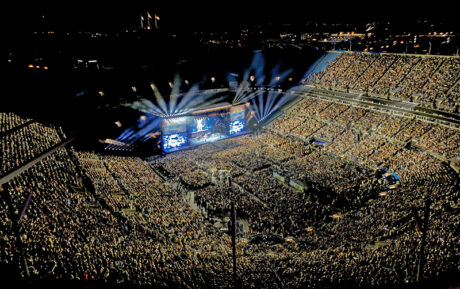
Good Lighting for Cameras and Audiences
The mandate from Chesney is for good lighting for all the cameras to capture the show for I-Mag, and for archival purposes. Swinford, Butts, and Ealy manage a fine balance of lighting for the audience in the stadium and the cameras. “This year’s design is basically good looking I-Mag and capturing video, which is the priority,” comments Swinford. “Though the show runs a lot hotter than any other broadcast TV lighting I do. We’re running higher irises than I normally would for broadcast, doing shows in the past like the CMA Festival or other live TV. For TV, I’d run the iris about 3.5 and maybe 40 or 50 footcandles (fc) on the spots or key lights. For this concert, it’s different because we want it to be impactful for the live audience, yet we don’t want to blow it out for camera. So, we’re running 80fc on Kenny and on the band when they’re soloing and things like that and running the iris at about 6.5. It looks really good on the I-Mag, and it looks nice and powerful to the audience. There’s always been a fine line between live and video lighting.”
Ealy acknowledges that fine line, “We approach the lighting of the show as if it’s for broadcast. Obviously, the live show is important, but the focus in the last couple of years, is in evolving the approach of lighting looks that are video-friendly. I’m always—as an old rock ‘n’ roll designer/director, I’m always fighting for the live show, but I’ve really embraced this new approach. It’s just a big picture that needs to be accurate and correct for our three big video screens. A lot of these larger shows now are taking the same sort of approach. In the end, it’s what the artist’s vision is, that is what we all have to work towards.”
In terms of the lighting rig, it couldn’t be simpler—there are only a few different types of lights, in Swinford’s rig. “I’ve got three trusses on the sides, and three in the back. We’ve got about 100 Robe FORTEs and a lot of the CHAUVET COLOR Strike Ms throughout that are used mostly for effects. The crew likes that we’ve only got a couple of kinds of lights in the rig. It’s all [Tyler Truss] GT Truss so it goes up very quickly. Ed Wannebo and Tom Nisun, our Stage Manager get the rig in, and out, quickly. It looks fabulous for video, and it looks good live the way it’s layered.” The COLOR Strike Ms were an upgrade to this year’s touring design. “We did want to do an all IP65 rated selection this year, so that’s been a nice upgrade,” comments Butts. “It’s 20 NFL stadium shows during the summer. At some point it’s going to rain. I knew that the IP65 ratings were going to be a big consideration, especially the LTXs up in the 300 level which are completely exposed.”
Butts concurs with Swinford about the simplicity of the design. “In a lot of ways, we treat it like a PAR can show,” says the programmer. “It’s very simple color and looks, in my mind. Kenny’s show is Kenny and the audience, and the music is the thing that binds them all together. It’s not a spectacle. It’s not lit like a rock show, it’s just illumination. That’s what it’s supposed to be. The cueing is simple, almost a throwback to how you would’ve done it in the 70s and 80s in some ways. Not to say it’s boring, it’s dynamic and interesting. It’s more about him, the audience, and the music. We try not to overwhelm that and be very much in a supportive role.”
For effects, and color strobing, Swinford is relying on CHAUVET’s COLOR Strike M, but not the strobe strip on the light. “We do color and have found the Strike Ms have the color LEDs on the top and bottom, with the white strobe strip in the middle,” the designer says. “We’re not using the strobe strip because we can’t control the color of it and it’s too harsh for him now. We do a lot of strobing effects with the lights when we need it. The Strike Ms are mostly for effects, and to make the rig bigger when it needs to be.”
Swinford also points out that the show is all manually operated by Ealy; no timecode at all. “Phil is so good, and his timing is so good, people probably think the show is on timecode, but it isn’t,” says the designer. “Also, Phil has stepped into the role of not just calling spots, and playing back all the cues, now he’s controlling the remote followspots at the console—cueing, color, intensity, everything. He manages all of that.”
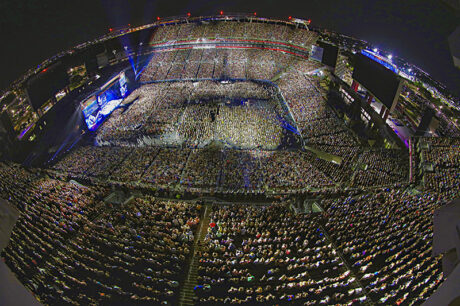
Lighting the Nation
A key thing that Chesney likes to see is the audience—not some of the time, but always. “The audience lighting is very important to Kenny,” Swinford says. “He wants to know that the guy in the highest, furthest seat is having a good time, and that Kenny is looking at him.” There is an entire audience lighting package as a part of the design. “We light the entire audience, all the time for the show, so it’s all exposed properly,” comments Butts. “That’s been our approach, especially in the last four or five years.” This is where the new ROBE iFORTE LTX WBs came into play with its high output. Swinford had been using Robe BMFLs for audience lighting but was looking for more output. A visit to Robe provided him with a solution. “I had gone over to the Czech Republic to visit the Robe factory. I was talking with the product designers, and Josef Valchar, the owner who asked me what I’d like to see in terms of lights. I asked if they could develop a long throw light that would give me 125 footcandles or so from 400’ and could be operated by the RoboSpot system.”
The result, “The LTX weighs 250 lbs., but it’s really bright, so we’re using them now and they’re working really well. We have headroom with them, so yes, we’re very pleased. We’re doing 400’-500’ throws across the stadium lighting the audience. Now, with the LTX, we can start doing color a lot more. Before because we needed all the horsepower we could get, which was only with Open White light. Kenny is not a big fan of Open White; it’s a little too stark for him. He really likes a lot of light pastel colors. He prefers a light CTO, or a pale blue. And for years, there’s never been magenta anywhere. Because of the horsepower of the LTX, we’ve been able to add color a lot more to the audience this year. So that’s very cool.”
The other factor that made the iFORTE LTX a good choice for the production was that the lights are all IP65 rated, so they hold up to rain, which is a distinct possibility with all Chesney’s stadium dates. The time it took to bag—and unbag all the audience lights in the upper reaches of the stadium were a big hit on the labor pool. “What is also remarkable about the LTX, is that they are all IP65,” notes Swinford. “Ed said he sure would like to have a light that we didn’t need to bag every time it’s supposed to rain, or every night when we’re done. So, now no worries about that at all.” It also helped that when asked for such a large quantity of these new Robe lights, the vendor, Solotech didn’t hesitate to acquire them for the tour. In addition to 172 Robe iFORTE LTXs, Swinford has 99 FORTEs, 12 MegaPointes, and 78 CHAUVET COLOR Strike Ms. That’s it.
The lighting team used Depence to previsualize for this tour. “We did a full visualization model with Kenny and put a monitor in front of him at FOH during rehearsals,” says Butts. “It was the first time I put it in front of an artist. It was another big thing for us as we could see all the audience lighting, move the camera around, and show Kenny what it would look like from where he stood on stage; what the audience would look like. This was a huge thing for us, especially for Kenny because we got the work of lighting the audience done; he’d seen it, gave input, and signed off on it. It was a gamechanger in terms of taking workload off him in the middle of crunch time. Matt Geasey and Clear All Visuals set up the Depence system for us.”
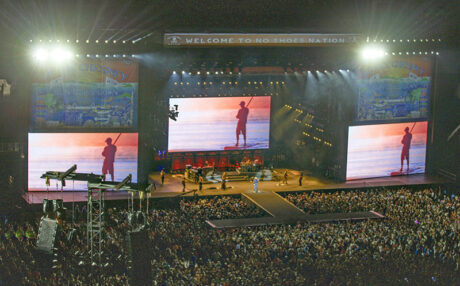
Remote Control
Another new thing Swinford added to his design this year are lights he could remotely control to light the bandmembers. “We have band key lights hanging off the cantilever of the Stageco roof all the way downstage,” he says. “Those are all on the RoboSpot system, so no matter where the band goes, they’re always in light for video. We’ve had some problems before with the band, where we’re doing graphic looks and maybe the band didn’t want to be spot lit all the time, so they’d find dark spots and then video had nothing to shoot. I wanted to fix that and make sure that they could never be out of the light. It’s really worked out well because now no matter what the band is doing on stage, there’s a picture for video.”
With the RoboSpots, Swinford and his lighting team have it set up, so the operators are only following their targets, doing the positioning. “All the colors, dimming, cueing—everything is done from the console,” explains Swinford. “It’s really tight, so when there’s a blackout, everything goes black together, and at once. There’s no lag. I also added rear followspots to Kenny this year. It’s something that I’ve wanted to do, and video has wanted to do for years, but he’d never really been open to the idea. So, I decided I would try it and show him how much better he looks on video. The live show is important too. He looked at it and he liked it, so we’re all happy about that. We have 11 active RoboSpot operators paired with the iFORTE LTX.”
In terms of I-Mag, they used to have outboard, vertically oriented screens hanging from the stage structure. They’ve always had scrims on the sides of the stage hiding the audio speakers. “This year, what we’ve done is put the I-Mag screens, in a 16:9 format at the bottoms of the side scrims with the tour artwork on them,” explains Swinford. “In the past, we’ve barely fit into some stadiums, so Ed wanted to reduce the width. So, now the top half, is scrim and the bottom is a video screen.” The screens consist of 6mm LED screens built into custom touring frames from NEP Screenworks. The media servers are the Tria from Ross Video and Disguise with Notch.
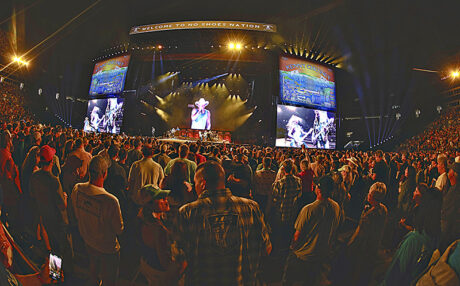
It’s All About the Hat
The show had a long rehearsal period at the Steel Mill in Nashville. Ealy talks about the fine tuning at the stadium for one very important show element. “At the Steel Mill, I use white Styrofoam wig heads with white t-shirts for targets for all the RoboSpot cueing,” Ealy explains. “Once we had the time in the stadium getting everything dialed in, we double checked all the levels of the followspots on Kenny. Until we got to Tampa for the final rehearsals, we’d never seen his hat. That’s always the most critical element, what does the hat look like on video? So, we had a stand-in, with a stand-in hat, because we can’t use the real hat. We took levels and did a camera balance one more time and found we were a little bit too hot. So, we reduced the footcandles on the front spots on him by 10%. We have a sweet spot and a have a little bit of headroom if we need it, but we’re not going to over flare the hat. It’s all about the hat.”
Shout Outs
Swinford, and his lighting team, are very happy with the support of Solotech, the lighting vendor for the tour. “Solotech’s support has been stellar, and their crew is stellar,” comments Swinford. We couldn’t ask for more. When I saw the LTX, I asked if they would be ready by March for our tour, and Robe shot them through. Solotech then said that they would get the lights, that they wanted to invest in it, that they saw its use for more than just Kenny’s tour; they wouldn’t be sitting on a shelf. Other tours will want them as well. I think Solotech got the very first shipment of them. They were really good about sticking to my design. Their cabling system is very clean as is their power distribution. Also, they packaged the RoboSpot controllers on carts that are really good, and friendly to tour with. There’s no assembling any of that. They just roll-in and we plug them in. It’s very good service, their crew is some of the best in the business and they get along with the Chesney touring family.”
Butts adds a shout out to Mike Marcario, the Front of House Technician. “He’s done a great job managing everything, the opening acts, all the merges, show files; all that stuff.” When it comes to someone having your back, Ealy agrees you want Marcario, as he relies on Marcario and his expertise dealing with the FOH and the lighting system. “I definitely credit Mike. He looks after all the networking and looks after me with his programming expertise. If there’s something I can’t figure out, he’s always there. He’s super knowledgeable and friendly. I couldn’t do it without him.”
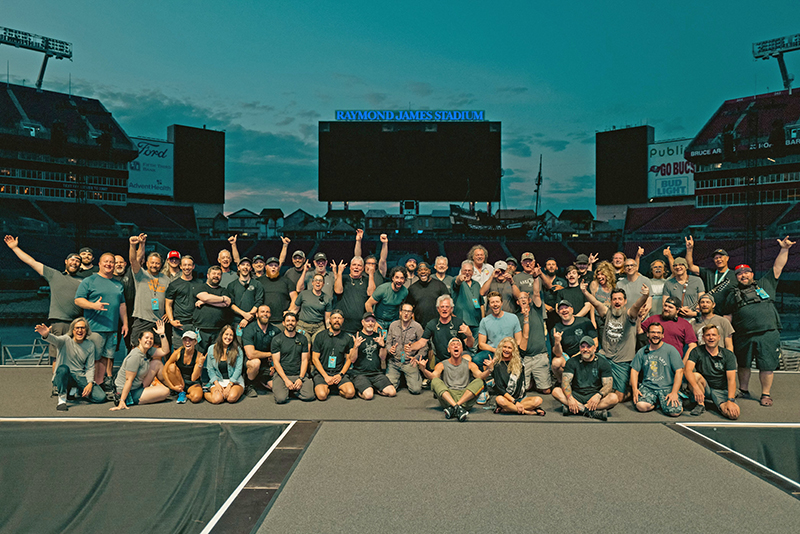
Working with Mr. Fun
Ealy, who goes way back with Wannebo to the latter’s days as a touring lighting crew chief, appreciates working with Swinford. “He’s been there forever and fortunately he allows me to give input when I feel strongly about something,” says Ealy. “A lot of times he’s open to it, so on a creative level, I do get an opportunity to have some input. Then throughout the tour, we do some dynamic adds that feel right after a few shows, you start seeing other things that could be cool. We try to implement that; if Mike and Mark are open to it, we do it.”
Both Swinford and Wannebo go back to the beginning of Chesney’s headlining tours, and Wannebo came up as a lighting crew chief, so they both get along very well. “We have a really great relationship,” comments Swinford. “We will look at what we’re doing and see how we can make it new, make it fresh. What’s the priority? For the last few years, Kenny is expecting a really good video picture. Then, how well do we light the audience, which is paramount for Kenny? Those two things drive it. Ed is very much in tune with Kenny and Kenny’s needs and relates that to everybody. He is very detail oriented. Ed was in lighting before he was a production manager, so when I came to him with the concept of adding more RoboSpots, which is more operators, to add the key lights to the band he got it completely, so that’s a real leg up when pushing ideas through to management and making it happen. We’re pretty tight; I love working with Ed. Always have. His nickname is Mr. Fun, after all. If I was ever to tour again, this is the tour I’d want to be on.” Ealy echoes those thoughts, and adds, “It’s just a wonderful organization to work with. Everybody is so friendly and respectful. It’s been a great experience that I hope continues for as long as we all can do it.”
Butts goes back the same amount of time with Wannebo, and has a lot of respect for the PM. “I can’t imagine another person doing this job. It’s one of those things where the fun and positive vibes start from the top. He’s one of those people that really sets the tone for everything. It’s just that attitude he has, and how well organized he is. He comes in every night after band introductions, he’s got this perfect margarita recipe that he makes for Kenny every night. It’s just all a part of that—let’s go have fun at work, do a great job, entertain everybody, and we all go home safe at the end of the night.”
Swinford notes that he appreciates and respects how involved Kenny Chesney, himself is with the lighting, noting, “He’s involved in every aspect of the show. He looks at every little thing and signs off on it. And all the time he’s doing this, he’s a nice guy. He does not come off as a control freak. The way he treats his crew and staff is like no other; it’s top notch.”
Each night, about halfway through the show, PM Ed Wannebo brings out his perfect margarita for Chesney, and on this tour, for Uncle Kracker who is duetting with Chesney. You can tell that they have a great rapport, and Chesney has nothing but love and respect for his touring family—just as he does for the whole audience. Keep an eye out for the No Shoes Nation when it comes to a stadium or amphitheater near you for a great, fun evening.
TOUR INTERVIEW
Production Manager Ed Wannebo
Being a stadium tour, what are some of the challenges that you think the design of the lighting rig has made either easier, or harder?
Really only easier. Previously, we didn’t have the horsepower or the function to really achieve the vision Kenny wanted. He knows how he wants the people who love this music to experience it. With a stadium, you have to kick with big boots; nuance and small things get lost. Big and bold translate to the back of the stadium. So, for him, lighting is a way to reveal and expand what’s happening; lit properly, the fans feel part of the show. Emotionally, you’re trying to amplify and accentuate what he’s trying to deliver. How people experience the show is informed by all of this.
Now, all of our fixtures are the same size. We’re getting 5 degrees to 52 degrees of zoom, so we can get coverage where we need it, and long throws whenever it’s called for. The precision and ease of navigating are awesome. And that’s why we light the audience from the back of the field. It’s 8 Robo lights [RoboSpots] all the way at the back, but it makes people being bathed in the light feel like they’re swept up and participating, instead of being outside the action, watching and enjoying. You can feel that and the lighting does that.
So adding the RoboSpots was an important decision impacting the overall experience of the show.
It impacts us in so many ways. From a safety perspective, that’s number one. We don’t have people in towers, scaling ladders up to platforms. If we have to make a change for any reason, no one has to climb up there during the show. Instead, we have 16 control stations for 14 followspots, all in one control area. It’s given us an integration and feeling of immediacy in the show – and everybody’s together in a safe place.
Also, they take up so much less space on the truck. They’re very power efficient; a hair dryer uses more electricity – and the yield is so much more. Before, we’d have six big cases of SuperTroopers, which took up so much space and didn’t have nearly the control.
And with so many of these shows taking place in outdoor stadiums, the Robo LTX (i-FORTE LTX) isn’t impacted by inclement weather. They’re IP65 rated, so if it rains, it doesn’t matter.
Beyond that, lighting for Kenny creates dynamics. For example, the decision to put individual key lights on all the band members ensures the video director always has a shot of the players. Before, if they wanted to cut away, some of the players would be in the dark in a hole in the look. Now, we can go to the band playing at any moment, and it keeps the focus on the music. Being able to cut to the band when it makes sense is huge, and so is being able to light the crowd from the back which brings them into the show. Some bands would just throw up big walls of white light, but Kenny doesn’t want to blind fans, isn’t into the flashing white. So, we have eight at the back of the field. It isn’t as obtrusive, and at the same time it lets more people feel seen.
It’s also added depth of field in terms of how people see the show: there’s light downstage which is being lit the way you expect; there are Marshall stacks behind; the video field above the Marshalls; even Kenny being lit from the back, plus the musicians… it adds a dynamic that isn’t so flat – you’re looking at something.
The audience lights are a huge component of this for us. We probably spend as much time on the audience lighting, to get that right, as anything. To really bring the No Shoes Nation audience in is the vibe Kenny is after; immersing the crowd in the show, in all of it. Kenny wants No Shoes Nation to be part of the experience and the lighting really plays a part in that feeling.
Talk a little about your working relationship with Mike Swinford and realizing the show.
I enjoy working with Mike, because he has a sense of making it work while also being a great designer. We met years ago when he had long blond hair and we were working with Rick Springfield. He was the lighting director, and I was the lighting crew chief working for Showco. We even did Carnegie Hall with Rick, so we’ve had years of working together. He understands my grasp of practicality; how the ability to move is an important factor, especially on a tour this size. We respect each other’s space very well, and I try to manipulate our situation to accommodate the design. He knows that. So, we try to the marry the presentation artistically and practically.
We are both trying to create the experience Kenny sees in his mind. Together I think we have been able to do that. We didn’t go from a few trucks to a mega show overnight. We’ve grown both the production and the show over the years, so we’ve integrated making it big along the way. We have a fairly minimal amount of gear (for a tour this size), and that has a massive impact. It is a big, bold look that’s amazing – and clean – and that’s in part because of the path we’ve taken.
And you have to realize: you don’t build this big show, then plop Kenny down in the middle of it; saying “Here’s the mark” and he has the production hung on him. People ask, ‘Do you have lasers? Do you have gas or smoke? Do you have pyro?’ No, we have him, we have Kenny. That’s way more powerful. Everything is about accentuating him, because he’s a force. There is so much charisma; it’s about supporting him and realizing his visual for how he wants the show to look. Then it’s about scaling properly for the venue.
TOUR INTERVIEW
Kenny Chesney, Country Artist and ‘No Shoes Nation’ Founding Father
Tell us a little about how important it is to you that the lighting ensures the audience feels a part of the show.
The lighting is how the people who aren’t down front get seen. Growing up, I was a guy buying the cheapest seats I could, because I wanted to rock hard. I was in those seats as a kid, and I know how much heart those fans have. They deserve to know they’re seen and felt. This year, I think Mike and Ed have really had a breakthrough in how well we can light them up without blinding them. I never want anyone overwhelmed by anything but the songs, the band, the music.
Can you tell us how important it is to having good communications, and a bit about the working relationships with the team.
Good communications unlock everything else. When people talk it through, you get the benefit of all the years of experience multiplied by all the people on my team. It’s a lot of math that yields a lot of creative function on what some people view as task-based items.
One thing about everyone in my road family, beyond being the best at what they do, they’re also always looking for new and better ways to do it. They’re constantly questioning, talking amongst themselves and some of their peers in the live concert world to see what the next innovation might be. And because we’re willing, we’ve been the first tour that a lot of technology has been deployed on. You can’t do those kinds of things if everyone isn’t talking, and also listening, to each other. That respect everybody has for each other is crucial.
And we have a lot of fun out here. There isn’t one person on the Sun Goes Down 2024 Tour who’s got “a job.” We’re all gypsies, in service of the music and the fans. Everybody has music playing all day, they’re joking about stuff – and that spirit is felt in everything! When Ed brings me that oversized margarita partway through the show, it’s not a gag, but an extension of how we feel. It’s toasting the fans and each other. That kind of friendship, you can’t buy, you have to find. I’ve been lucky: with my team, like finds like.
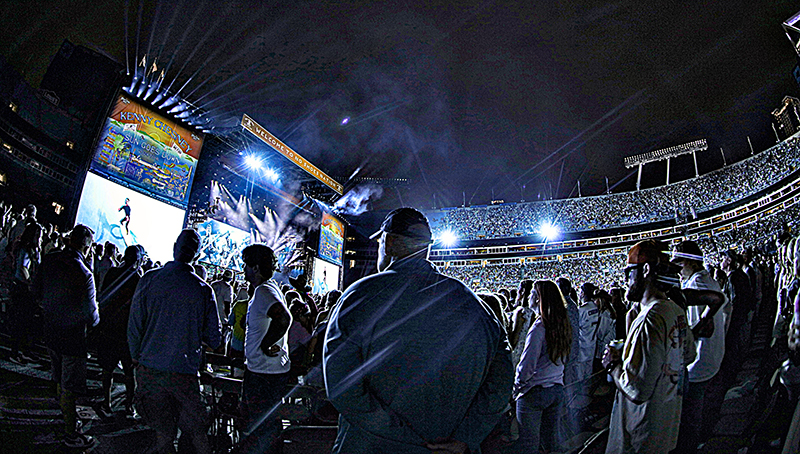
VENDOR VIEWS
Joseph Logsdon – Account Manager, Solotech
On what Solotech provided beyond gear for this production:
Our team really dove deep into the network system design. Our project managers are something else—they’re not just passionate; they have this knack for seeing the client’s vision and making it a reality. The stadium carts for example were custom fabricated and modified further in our shop to meet the needs of a stadium lighting package. We tailored everything specifically for this production from the height of the lighting console for Phil Ealy, to cases and carts systems which are designed and built to save on time during load in and load outs.
On supporting LD Mike Swinford and PM Ed Wannebo:
Mike Swinford’s expertise in TV lighting is second to none. It truly takes the show to another level with his ability to design a lighting system that supports truly exceptional key light. Most of the audience is seeing the performance through screens and Mike’s magic with the key light makes it feel like you’re right there next to Kenny. It’s super vivid.
And working with Ed Wannebo has been one of the highlights for me. Ed’s approach isn’t just about steering the ship; it’s about setting a course that everyone believes in. His leadership creates this positive vibe that spreads through the entire team. Recently, he’s been pioneering our transition to sustainable practices, championing initiatives like reducing waste and improving energy efficiency. It’s inspiring; makes you want to up your game and contribute to something truly special—both innovative and environmentally conscious.
On why Solotech was the right vendor for this production:
Because our team is driven by a passion for what we do, and we care. We combine years of industry experience. Solotech focuses its resources on the goals of the client; if our clients are successful we are.
Brian Littleton – Project Manager, Screenworks NEP
On what Screenworks provided beyond the gear:
Packaging and efficiency for multiple types of venues. We have been able to provide to the production team an LED product in a packaging that suits the needs of both stadiums and sheds for efficiency and the weather elements. By using our 6mm product in larger cart and frame configuration we have provided a large screen package in minimal cart space; a screen robust enough to withstand the constant weather challenges of a summer tour.
On supporting Video Director Jay Cooper and PM Ed Wannebo:
Working with Jay “Coop” is always easy. He has been with Kenny for so many years that Kenny trusts Jay to put people and cameras in the right places to complement Kenny’s fast paced show from start to finish. Going into production rehearsal’s Coop is ahead of the game, because he, Kenny and Ed have discussed any new items to be addressed for the upcoming tour. Coop can dive into the show programming from day one and by the time they hit the first show it is very well polished product to screens.
The one thing I always know is Ed has done his homework. When we begin pre-production talks with Ed the amount of information he has already is astonishing. From day one he can rattle off distances between trusses and trim heights for every department. He can tell you exactly what challenges will be faced at a particular venue somewhere down the line, so we are always able to stay one step ahead with Ed. It makes all our jobs seem easier and more efficient and it shows with some of the smoothest stadium production load-ins and outs in the business.
On why Screenworks was the right vendor for this production:
We have provided the video package for Kenny for the last 21years, working directly with Ed and his team each year to provide not only a high-quality show but the right people to fit the “family” and culture that’s needed to make that machine run all summer.
PRODUCTION TEAM
- Production Manager: Ed Wannebo
- Stage Manager: Tom Nisun
- Lighting Designer: Mike Swinford, Uplate Design
- Lighting Programmer: Mark Butts
- Lighting Director: Philip Ealy
- Lighting Crew Chief: Kevin Tyler
- FOH Technician: Mike Marcario
- Dimmer Technician: Tommy Smith
- Moving Light Technician: Alex Ehler
- LX Techs: Daniel Duncan, Moss Everhard
- RoboSpot Tech: Nick Monaco
- Stadium Lead: John Nichols
- Stadium LX Tech: Brace Balthrop
- Dock Master: Dwayne Gibson
- Video Director: Jay Cooper
- Camera Engineer: Corey Neal
- Video Crew Chief: Grit Frederick
- LED EIC: Clay Sprankle
- LED/Cameras: Jay Trimble, Baylor Masincoup
- Cam/Utilities: Maria Passalacqua, Paul Page
- Jib Op: Jaimie Cantrell
VENDORS
- Lighting: Solotech, Joseph Logsdon, Acct. Exec.
- Video: NEP Screenworks, Brian Littleton, PM
- Rigging, Automation: SGPS
- Soft Goods: Britten, Inc.
- Previsualization: Clear All Visuals
- Barriers: Guardian Barrier Services
- Trucking: Upstaging
- Busing: Dreamliner
GEAR
Lighting
- 172 Robe iFORTE LTX WB
- 99 Robe FORTE
- 12 Robe MegaPointe
- 14 Robe RoboSpot Controller
- 78 CHAUVET COLOR Strike M
- 2 grandMA3 full-size Console
- 1 grandMA3 light Console
- 1 grandMA3 compact XT Console
- Luminex network setup
Video
- Ross Vision Video Switcher
- Ross Tria Media Server
- Disguise Server with Notch Effects
- 6mm LED Video Screens w/ Custom Frames
- NovaStar H9 Processing
Camera Package
- 4 Wide Angle Handheld Lens
- 2 111x Long Lenses at FOH
- 2 Panasonic PTZ Camera
- 1 24’ Jimmy Jib
